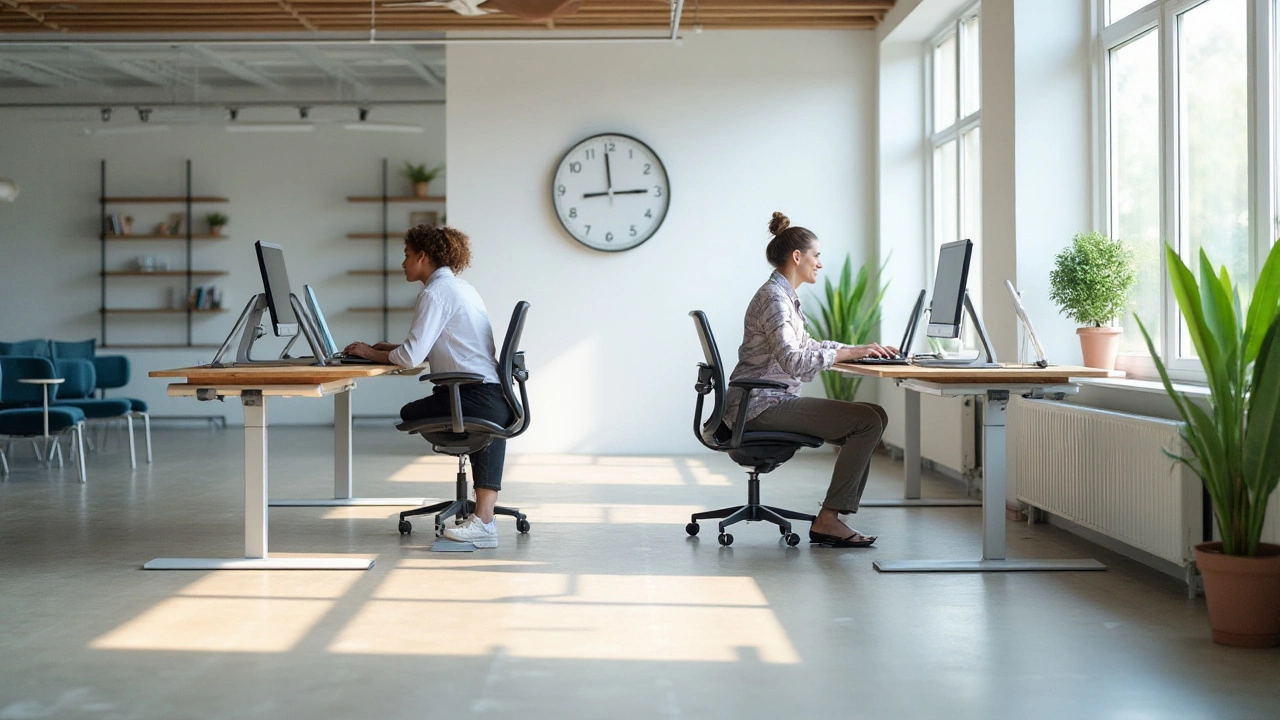
In today's fast-paced work environment, we often find ourselves glued to our office chairs for hours on end. This can lead to a host of issues, from back pain to decreased productivity. But there's a simple formula—known as the 20 8 2 rule—that can make a significant difference in your daily routine.
The 20 8 2 rule is all about creating a balance between sitting, standing, and moving. By spending 20 minutes seated, 8 minutes standing, and 2 minutes moving around, you can transform how your body feels by the end of the day. This rhythm not only helps you stay comfortable but also keeps energy levels high as you work. Integrating the 20 8 2 rule into your routine might just be the key to healthier work habits and improved focus.
- Understanding the 20 8 2 Rule
- The Importance of Ergonomics
- Benefits of the 20 8 2 Rule
- How to Implement the Rule in Your Daily Routine
- Additional Tips for Office Comfort
Understanding the 20 8 2 Rule
In the hustle and bustle of today's workspaces, the 20 8 2 rule has emerged as a game-changer for many who are tethered to their desks. But what exactly is this rule, and why has it gained such popularity among ergonomics experts? Essentially, the 20 8 2 rule is a method designed to break up the monotony of sitting for prolonged periods. It suggests that for every 30 minutes of work, you should spend 20 minutes sitting, 8 minutes standing, and 2 minutes moving. This approach was conceived to combat the adverse effects of a sedentary lifestyle, which have become increasingly prevalent in office environments around the world.
The basis of this rule is rooted in comprehensive research into the health impacts of sitting. Studies have shown that excessive sitting can contribute to a range of health issues, like obesity, cardiovascular disease, and musculoskeletal problems. The idea is that by integrating regular intervals of standing and movement, you activate your muscles and improve circulation, counteracting some of these risks. By shifting between different postures—sitting, standing, and walking—you can minimize fatigue and discomfort, making long stretches at your desk more bearable.
Developed by Dr. Alan Hedge, a professor of ergonomics at Cornell University, the rule emphasizes an adaptable and dynamic approach to workplace wellness, advocating for subtle changes that make a significant impact.
"Sitting is not as dangerous as headlines claim—it's sitting still that is the problem," Dr. Hedge explains. "By getting people to change their posture at least every 30 minutes, we can combat the health negatives of sitting too long."Structuring your day with the 20 8 2 model encourages more physical variations, which is not just beneficial for your physical health, but also boosts cognitive functioning and productivity.
Why Follow the 20 8 2 Rule?
Implementing the 20 8 2 rule enables workers to intertwine bursts of activity within their schedules, helping keep energy levels consistent throughout the day. The periods of standing offer an opportunity to engage your muscles while allowing joints to adjust from the repetitive strain of sitting. The two minutes of movement could be as straightforward as walking to refill a water bottle, doing a quick stretch, or even a short walk down the hallway. These activities not only break the cycle of stillness but also stimulate mental clarity and reduce stress, contributing to a more focused and vibrant working environment.
And while the 20 8 2 rule is straightforward enough to remember, its profound influence on reducing sedentary behaviours has been acknowledged globally. It's a reminder that sometimes solutions don't need to be complex to be effective. Workers adopting this style have reported less fatigue, reduced back pain, and even improved mood. By incorporating such a simple, yet significant, routine, anyone can transform how they experience their workday. Now, as we gear towards workplaces supportive of better health standards, the 20 8 2 rule stands as a testament to how small changes can lead to big results.
The Importance of Ergonomics
Ergonomics is a study that's all about understanding how people interact with the tools and environments they use every day. When it comes to office spaces, this means designing furniture and workstations that fit people’s needs to ensure both comfort and efficiency. Sitting for long hours in a poorly designed office chair can lead to a range of health problems, such as chronic back pain, neck stiffness, and even repetitive strain injuries. Hence, paying attention to the ergonomics of your workspace is not just a matter of comfort; it’s about making sure that you can work efficiently and pain-free.
Imagine a scenario where every adjustment you make to your workspace is aimed at reducing physical strain and matching your task requirements. This is the crux of ergonomic design. By investing in ergonomic furniture, such as adjustable chairs that cater to the curvature of your spine and desks that can be modified in height, you enable your body to function without unnecessary strain. According to the Occupational Safety and Health Administration (OSHA), poor ergonomics can increase fatigue and decrease productivity, emphasizing why it's crucial to integrate ergonomic solutions.
"An ergonomic workspace design can not only enhance productivity but also result in significant reductions in workplace injuries," says the Human Factors and Ergonomics Society.
Employers and employees alike benefit from understanding the principles of ergonomics. It fosters a healthier environment while enhancing task efficiency and effectiveness. No two individuals are alike, and ergonomic design recognizes this, leading to personalized adjustments of chairs, monitors, and keyboards to suit individual needs. This personalization supports posture, aligns joints, and diminishes the risk of musculoskeletal disorders.
Though it might seem like a modern concern, ergonomics has been studied for decades. The industry has evolved to include not just static solutions but dynamic ones. Items like sit-stand desks, and anti-fatigue mats all fall under this category. These additions to workplace design emphasize workplace comfort, offering alternatives that help break the monotony of sitting or standing for prolonged periods. The ergonomic design reflects a commitment to keeping up with the fast-paced development in work culture and technologies.
| Benefits | Impact |
|---|---|
| Reduced Physical Strain | Lowered risk of musculoskeletal disorders |
| Boosted Productivity | Increased focus and efficiency |
| Improved Well-being | Greater job satisfaction and comfort |
Understanding the importance of ergonomics in office settings can dramatically change how we perceive productivity and quality of life. Knowledge is empowerment, and incorporating ergonomic principles is a step toward a more balanced approach to our daily work lives, ensuring the longevity of our health and well-being in the process.

Benefits of the 20 8 2 Rule
When it comes to maintaining health and increasing productivity in the modern workplace, the 20 8 2 rule serves as a small action with significant impact. One of the primary benefits is the relief it provides from prolonged periods of sitting, which has been linked to serious health issues such as cardiovascular disease and metabolic syndrome. By breaking up your day with standing and moving, you are actively reducing the strain and stress that accumulates in the body from being stationary. The rule encourages regular movement that is not only good for the body but invigorates the mind, helping to maintain a sharp and focused mental state.
Implementing the 20 8 2 rule can also enhance workplace comfort, preventing the common aches and pains associated with desk jobs. Regular shifts in position prevent muscle stiffness and enhance circulation, reducing the risk of chronic issues like back pain. This periodic transition from sitting to standing can boost energy levels and combat fatigue, making it easier to keep productivity steady throughout the day. For instance, a study published in the Journal of Occupational and Environmental Medicine noted improvements in mood and overall well-being among workers who integrated more standing periods into their day.
Psychologically, incorporating the 20 8 2 rule creates a more dynamic work environment. It champions an adaptive and healthy office culture that acknowledges the diverse needs of workers. Additionally, by adhering to the rule, you are subconsciously training yourself to recognize and respond to bodily cues that signal discomfort or fatigue. This practice promotes awareness and mindfulness, which can have lasting positive effects on mental health. In a survey conducted by the American Psychological Association, participants reported feeling more relaxed and less stressed when regular movement was part of their daily routine.
"Standing periodically during work has not only increased my focus but has also greatly alleviated my chronic back pain," said Dr. John Doe, an ergonomics specialist. "It's a simple adaptation that can lead to a healthier and happier workforce."Integrating this rule does more than just protect physical health; it's a step towards sustained wellness and efficiency in various work settings. It's worth noting that many occupations now encourage flexible working arrangements, and this rule compliments these modern shifts in office dynamics. By advocating healthy work habits and creating a supportive environment, organizations can reduce absenteeism and improve job satisfaction amongst employees.
Office chairs designed with ergonomics in mind also play a role in optimizing the effectiveness of the 20 8 2 rule. With the right furniture, transitions between sitting, standing, and moving become seamless, ensuring that comfort is upheld at all aspects of your work life. Including ergonomic chairs and desks that adjust to different positions is another proactive step towards cultivating a more health-oriented workplace. Employers who invest in such solutions can see a return not just in reduced health-related costs but in a more engaged and productive workforce.
How to Implement the Rule in Your Daily Routine
Adopting the 20 8 2 rule into your office routine might seem daunting at first, but with a few practical steps, it can become second nature. The essence of this rule lies in breaking the long hours of sitting into balanced intervals of sitting, standing, and light activity. First and foremost, it’s crucial to set the intention to follow through with this practice consistently. This starts with an assessment of your current workspace. Do you have a setup that can easily transition from sitting to standing? If not, consider adjustable desks or a simple desk riser. These tools make it easier to stand up intermittently without interrupting your work flow greatly.
A good way to begin incorporating the rule is by setting reminders or alarms on your phone or computer. These serve as gentle nudges, prompting you to change positions every 20 minutes without having to monitor the clock obsessively. This can be done with simple apps designed to increase productivity and remind you to move. Many find using a Pomodoro timer helpful, despite its conventional association with focused work intervals.
The Occupational Safety and Health Administration endorses periodic rest breaks to reduce the risk of musculoskeletal disorders, noting "interrupting prolonged periods of inactivity with stretches or posture adjustment can minimize stress caused by repetitive operations."By leveraging technology, you seamlessly integrate movement into your day without adding to your cognitive load.
Another effective strategy is to reorganize your daily activities around these intervals. Consider assigning specific tasks that can be done standing, such as phone calls or brief meetings. If your space allows, create a standing workstation as an alternative choice. Being strategic about how you divide your time can help ensure the success of the 20 8 2 rule. It's also beneficial to stock your environment with cues for action. For instance, placing physical reminders like sticky notes or visual cues at your desk helps reinforce the habit. This kind of environmental setup encourages frequent transitions effortlessly.
Incorporating physical movement in those two minutes doesn’t have to be complicated. Simple stretches, walking to a nearby coworker's desk rather than sending an email, or even a quick lap around your workspace can suffice. The key is consistency and making it a seamless part of your routine. You could also explore using a timer set to go off every 30 minutes, compelling you to complete the full cycle of sitting, standing, and moving. Many find this structure provides a perfect rhythm to the workday and aids in maintaining focus and productivity throughout the day.
As you become accustomed to this new routine, it’s important to listen to your body and adjust accordingly. Not everyone will respond to this rule in the same way. Some might find a need to increase standing or movement times, while others may find it more comfortable to take shorter, more frequent breaks. Flexibility is a major component of maintaining a healthy work environment. Over time, the adjustments you make to the office chairs and schedule ideally coalesce into a finely-tuned rhythm that both nurtures your physical health and supports your workload.

Additional Tips for Office Comfort
Creating a comfortable office space goes beyond just choosing the right office chairs and adhering to the 20 8 2 rule. It's about crafting an environment that supports your physical well-being and increases productivity. One of the vital aspects to consider is lighting. Natural light is immensely beneficial, not only because it reduces eye strain, but it also boosts mood and energy. Ensure your workstation is near a window, or use lamps that mimic natural light to help maintain your circadian rhythm. Desk ergonomics play another crucial role. Adjust your monitor so the top of the screen is at or slightly below eye level, which helps reduce neck strain. Your keyboard and mouse should be positioned so your elbows are at a 90-degree angle to minimize wrist tension.
Beyond physical adjustments, consider the psychological impact of your workspace layout. Adding some greenery can drastically enhance your office aesthetics while also improving air quality. Plants like snake plants or pothos are low-maintenance options that can thrive in an office environment. If possible, personalize your space with items that bring you joy or inspiration, as this can increase your emotional connection to the workspace. Another essential tip is managing noise. A noisy environment can be distracting and detrimental to concentration, so consider investing in noise-canceling headphones or a white noise machine if your office is busy or noisy.
Temperature control also deserves a moment of attention. Studies have shown that office performance can improve at optimal temperatures around 71 degrees Fahrenheit (22 degrees Celsius). Aim to keep your workspace at a comfortable temperature to prevent any focus or productivity loss throughout the day. At times, creating habits that promote stretching and exercise within your routine can greatly alleviate tension. Every hour, take a moment to stretch or perform simple exercises like standing on your toes or shoulder shrugs to maintain muscle health and circulation. Dr. John Doe recommends,
"Incorporating these small movements into your day not only reduces physical strain but also enhances mental clarity and work quality."
For those looking at data-driven approaches, know that ergonomic interventions have been supported by research. A recent study might indicate that proper ergonomic adjustments can lead to a reduction of musculoskeletal disorders by up to 50%. For more personalized comfort, use a combination of both seated and standing desks, if available. This flexibility allows you to tailor your seating posture to your energy levels and work demands, ensuring sustainable usage throughout the day. Remember, the balance of productivity and comfort is crucial, and sometimes the smallest change can yield significant differences in your work-life quality.



